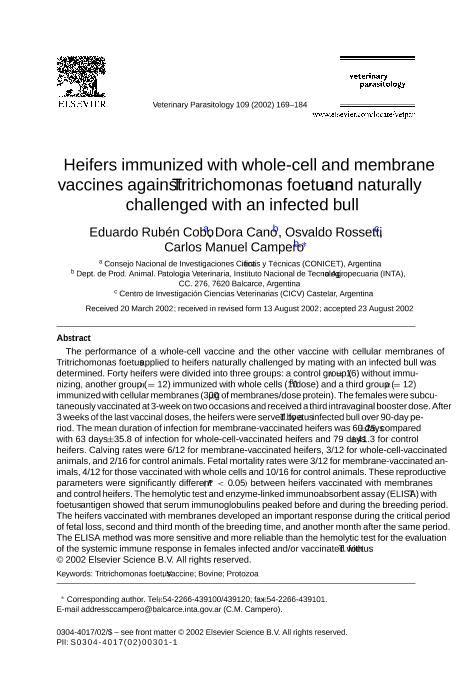Mostrar el registro sencillo del ítem
dc.contributor.author
Cobo, Eduardo Ruben

dc.contributor.author
Cano, Dora
dc.contributor.author
Rossetti, Osvaldo Luis

dc.contributor.author
Campero, Carlos Manuel

dc.date.available
2019-04-11T15:01:49Z
dc.date.issued
2002-11
dc.identifier.citation
Cobo, Eduardo Ruben; Cano, Dora; Rossetti, Osvaldo Luis; Campero, Carlos Manuel; Heifers immunized with whole-cell and membrane vaccines against Tritrichomonas foetus and naturally challenged with an infected bull; Elsevier Science; Veterinary Parasitology; 109; 3-4; 11-2002; 169-184
dc.identifier.issn
0304-4017
dc.identifier.uri
http://hdl.handle.net/11336/74031
dc.description.abstract
The performance of a whole-cell vaccine and the other vaccine with cellular membranes of Tritrichomonas foetus applied to heifers naturally challenged by mating with an infected bull was determined. Forty heifers were divided into three groups: a control group (n = 16) without immunizing, another group (n = 12) immunized with whole cells (108/dose) and a third group (n = 12) immunized with cellular membranes (300 μg of membranes/dose protein). The females were subcutaneously vaccinated at 3-week on two occasions and received a third intravaginal booster dose. After 3 weeks of the last vaccinal doses, the heifers were served by a T. foetus infected bull over 90-day period. The mean duration of infection for membrane-vaccinated heifers was 60 days ±25, compared with 63 days ±35.8 of infection for whole-cell-vaccinated heifers and 79 days ±41.3 for control heifers. Calving rates were 6/12 for membrane-vaccinated heifers, 3/12 for whole-cell-vaccinated animals, and 2/16 for control animals. Fetal mortality rates were 3/12 for membrane-vaccinated animals, 4/12 for those vaccinated with whole cells and 10/16 for control animals. These reproductive parameters were significantly different (P < 0.05) between heifers vaccinated with membranes and control heifers. The hemolytic test and enzyme-linked immunoabsorbent assay (ELISA) with T. foetus antigen showed that serum immunoglobulins peaked before and during the breeding period. The heifers vaccinated with membranes developed an important response during the critical period of fetal loss, second and third month of the breeding time, and another month after the same period. The ELISA method was more sensitive and more reliable than the hemolytic test for the evaluation of the systemic immune response in females infected and/or vaccinated with T. foetus.
dc.format
application/pdf
dc.language.iso
eng
dc.publisher
Elsevier Science

dc.rights
info:eu-repo/semantics/openAccess
dc.rights.uri
https://creativecommons.org/licenses/by-nc-nd/2.5/ar/
dc.subject
Bovine
dc.subject
Protozoa
dc.subject
Tritrichomonas Foetus
dc.subject
Vaccine
dc.title
Heifers immunized with whole-cell and membrane vaccines against Tritrichomonas foetus and naturally challenged with an infected bull
dc.type
info:eu-repo/semantics/article
dc.type
info:ar-repo/semantics/artículo
dc.type
info:eu-repo/semantics/publishedVersion
dc.date.updated
2019-03-27T17:06:34Z
dc.journal.volume
109
dc.journal.number
3-4
dc.journal.pagination
169-184
dc.journal.pais
Países Bajos

dc.journal.ciudad
Amsterdam
dc.description.fil
Fil: Cobo, Eduardo Ruben. Instituto Nacional de Tecnología Agropecuaria; Argentina. Consejo Nacional de Investigaciones Científicas y Técnicas; Argentina
dc.description.fil
Fil: Cano, Dora. Instituto Nacional de Tecnología Agropecuaria; Argentina
dc.description.fil
Fil: Rossetti, Osvaldo Luis. Instituto Nacional de Tecnología Agropecuaria; Argentina
dc.description.fil
Fil: Campero, Carlos Manuel. Instituto Nacional de Tecnología Agropecuaria; Argentina
dc.journal.title
Veterinary Parasitology

dc.relation.alternativeid
info:eu-repo/semantics/altIdentifier/url/https://www.sciencedirect.com/science/article/pii/S0304401702003011
dc.relation.alternativeid
info:eu-repo/semantics/altIdentifier/doi/http://dx.doi.org/10.1016/S0304-4017(02)00301-1
Archivos asociados
